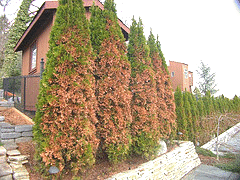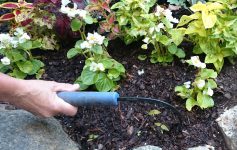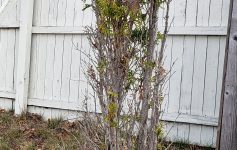Last week I wrote about the causes and traditional practices to “cope” with winter damage. But in the spirit of sustainability…there are options in your landscape designs, versus coping after the fact. Loses in landscape material is not only costly…but often unnecessary. Now not all of us are able to redesign on a whim longstanding poorly designed landscapes. But may I suggest addressing the issue when you have time and resources to re-design a “garden room” at a time. If you are considering an aggressive garden makeover, this is a perfect opportunity to totally resolve the issue with better plant selections, site assessment and practices. Allow me to take the elements I discussed last week and think outside the box for future designs.
First and foremost, once the snow has melted, take time to assess your site thoroughly. Given our discussion last week, you must first properly identify or diagnose the cause. Is it snow, salt, or wind damage. What are the growing conditions of that area: a wind tunnel of sorts, dry, nearby roadway? Identifying this, you can begin to apply options to minimize and possibly eliminate damage next year.
Branches broken from roof snow fall can be managed better with the installation of foundation drip lines. I usually design 2.5-3 foot areas as the backdrop for my plantings. Metal roofs common in our region pose extra challenges…so installing the well fitting/open slotted wooden tepees are always an extra benefit. Some trees just withstand open wind tunnel-like areas better than others. Those with willowy growth habits provide more forgiving qualities. If you have a specimen you want to keep, consider transplanting to a site more compatible with the tree/shrub properties (right plant right place philosophy).
The key to reducing wind desication is adequate soil moisture particularly throughout the summer and fall. Do you need to think about installing automated irrigation system? Damaged plants need about an inch of water /week according to a University of Nebraska report. I cannot stress the importance of good mulching practices annually! Installing 2-3 inches around the base of your trees and shrubs help retain moisture all season. You may also consider transplanting that specimen to a more protected area on your property. And lastly, late fall installation of a burlap screen….NOT A WRAP! will give you winter protection. Staple it to stakes then roll it up and store in the spring for re-use next fall.
For salt damage, look at your plant placement.If it is subject to roadway salt spray or run off, consider a bedding area 30-40 feet from the roadway. Another design trick I use is creating a berm (raised mounted bedding area) where the salt soil penetration may be high. This may help the salty run off water from moving into the root systems. When selecting new plants for these problem areas, consider those that have a moderate to high salt tolerance.
Looking for a suggested plant list that can help you reduce winter damage when you redesign? Contact me for selections I use successfully in my designs throughout our region.




